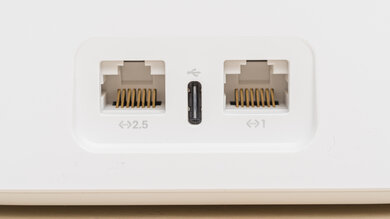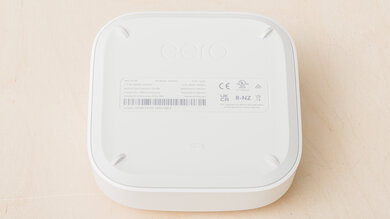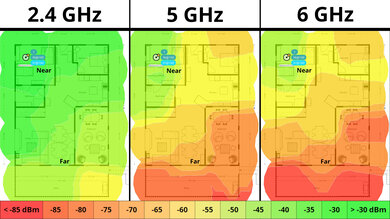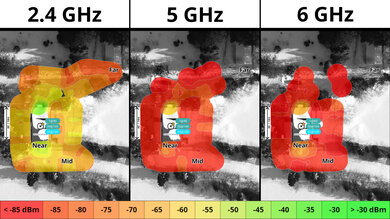The eero Pro 6E is a tri-band Wi-Fi 6E router with a 2.4GHz band, a 5GHz band, and a 6GHz band. It's available as a single router or in packs of two or three for mesh networking. It has a sleek design with a small footprint, a low profile, and no external antennas. It features a built-in Zigbee smart home hub and support for Amazon Alexa. You manage it through eero's mobile app, where you can configure basic settings. The app has a paid subscription tier that allows you to access additional features like ad blocking, content filters, and a VPN. We bought a two-pack and tested it in both mesh mode and standalone mode.
Our Verdict
The eero Pro 6E is a great router for apartments, condos, or small homes. Its attractive design and small footprint will easily fit into your living space. It provides great speeds suitable for bandwidth-heavy internet activities, like quickly downloading large files. It also has a 2.5 Gbps wired networking port.
- Small and sleek design.
- Built-in smart home integration.
- Impressive top speeds.
- Have to pay an additional subscription fee for advanced features.
- Only two networking ports.
The eero Pro 6E is a very good router if you have a medium- to large-sized home with a backyard. It provides great speeds suitable for bandwidth-intensive internet use, like 4k video streaming on multiple devices and quickly downloading large files, no matter where you are in the house. You can easily add access points to a mesh network for better coverage. It only has two wired networking ports, but only one is rated for 2.5 Gbps.
- Small and sleek design.
- Great range performance.
- Can add additional mesh access points to improve range.
- Built-in smart home integration.
- Impressive top speeds.
- Have to pay an additional subscription fee for advanced features.
- Only two networking ports.
The eero Pro 6E delivers great speeds that are suitable for a 1 Gbps internet connection or higher. It also supports Dynamic Frequency Selection (DFS), so it can use less congested DFS-only channels to give you better speeds in noisy wireless environments.
- Impressive top speeds.
The eero Pro 6E has very good range performance. Since it's a mesh router, satellite access points help it maintain consistent average speeds over long distances, making it suitable for high-bandwidth uses and high-speed downloads over a wide area.
- Great range performance.
- Can add additional mesh access points to improve range.
Changelog
- Updated Dec 16, 2025: We've added an MLO Implementation test for Test Bench 0.8.2! Read the changelog for more details.
- Updated May 01, 2025: We've converted this review to Test Bench 0.8.1. This includes a new test result for our Test Configuration box.
-
Updated Nov 15, 2024:
We've added a link to the newly-reviewed ASUS ZenWiFi ET9 in the Network Ports section.
-
Updated Oct 30, 2024:
We've added links to the newly reviewed TP-Link Deco BE63 and TP-Link Deco BE65 Pro in the Wi-Fi Specifications section of the review. We've also removed our speculation in as to why the 6GHz band is slower when connected to the satellite unit thanks to user feedback.
Check Price
Differences Between Sizes And Variants
This router is available on its own or in a two- or three-pack. We bought and tested a two-pack. Here's a photo of our unit's label.
Popular Router Comparisons
The eero Pro 6E is a Wi-Fi 6E router with 2.4GHz, 5GHz, and 6GHz bands. It shares many features with other eero routers, including mesh networking with additional access points and compatibility with Zigbee smart home devices. eero offers an "eero Plus" membership that allows you to access advanced settings and additional features like ad blocking, content filters, and VPN access.
This router and other eero routers stand out because of their ease of use and setup, integration with smart home features, and sleek design. You have to use the eero app to set up and manage the network, and there's no web interface at the time of writing. It's convenient and easy to use, but it's not very flexible, as there are very few configurable options you can change compared to standalone routers and even some other mesh systems. Performance-wise, the eero 6E has slightly better speeds and range than other Wi-Fi 6E routers, but it's usually more expensive.
The eero Pro 6 is a discontinued Wi-Fi 6 router; the eero Pro 6E is a Wi-Fi 6E router that replaces the former. They're both tri-band routers, but the Pro 6E's third band is 6GHz instead of 5GHz. The Pro 6E is a better router since it can reach higher top speeds and has better range. It also has a 2.5Gbps networking port, while the Pro 6 only has a single gigabit networking port. They're both designed for mesh networking; you can easily add more access points for better coverage.
The eero Pro 6E is a tri-band Wi-Fi 6E router, while the eero 7 is a dual-band Wi-Fi 7 router. Both routers have 2.4GHz and 5GHz bands, but the Pro 6E has an additional 6GHz band. As such, it delivers significantly faster speeds and better range than the eero 7. That said, the eero 7 touts some Wi-Fi 7 exclusive benefits like MLO (multi-link operation), allowing compatible devices to connect to multiple bands at the same time.
The eero Pro 7 and the eero Pro 6E are tri-band mesh routers from eero's 'Pro' lineup. The Pro 7 is a Wi-Fi 7 router, while the Pro 6E is a Wi-Fi 6E router. Performance-wise, the former offers better speeds and range on its 6GHz band, but the latter has a significantly more performant 5GHz band. Other than the Pro 6E being smaller and easier to place, the two offer very similar functionality.
The eero Pro 6E and the Google Nest Wifi Pro are Wi-Fi 6E routers designed for use in a mesh network. The eero is better overall since it can reach higher top speeds and has better range.
Test Results

This router has two networking ports that automatically detect whether you use a WAN or LAN connection. However, you'll have to buy an external network switch if you have many wired devices.
If you're looking for a router with more network ports, check out the ASUS ZenWiFi ET9.
While this router has a USB-C port, it's only used for power and doesn't support data transfer.
We tested this router in dual mesh mode. While there's a slight speed penalty when connected to the satellite, this is expected, and the additional access point helps deliver more consistent speeds over very long distances.
We tested this router in dual mesh mode.
Wi-Fi 6E gives access to the 6GHz band, which takes advantage of less signal interference for faster speeds, but you'll need devices that support it to benefit from it.
If you're interested in a Wi-Fi 7-capable mesh router, check out the TP-Link Deco BE63 or the TP-Link Deco BE65 Pro.








